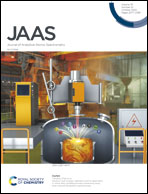Forensic float glass fragment analysis using single-pulse laser ablation inductively coupled plasma time of flight mass spectrometry
Abstract
The most discriminating method that is currently applied in routine forensic elemental analysis of glass is laser ablation in combination with quadrupole or sector field based inductively coupled plasma mass spectrometry (LA-ICPMS) following the standard method ASTM E2927-16E1. Due to the sequential measurement method, sample size constraints of approximately 400 μm × 200 μm × 100 μm with six individual measurements have been reported to provide optimum parameters for glass discrimination. The necessary sample size is given by the spot size, number of laser pulses per replicate and number of replicate measurements. In this study, a single-pulse laser ablation inductively coupled plasma time of flight mass spectrometry (Single-Pulse LA-ICP-TOFMS) method was developed and applied for the matching and mismatching of forensic float glass evidence. 110 laser pulses with an ablation spot diameter of 90 μm were applied to float glass fragments of a size below 400 μm in diameter. 18 elements were quantified from each individual laser pulse in order to compare the corresponding concentrations between various glass fragments. In contrast to previous work, a modified 5-sigma criterion was used to successfully match fragments from the same source and mismatch fragments from differing sources. The data set generated within this study demonstrates new capabilities when using quasi simultaneous signal detection and reduced the necessary sample volume from 400 μm × 200 μm × 100 μm to 100 μm × 100 μm × 33 μm, which corresponds to a reduction in sample material from 20 μg to 0.8 μg. The proof of concept is shown for the application of a single-pulse based method for glass fragment analysis in a forensic context, which would allow the measurement of smaller fragments than previously possible.



 Please wait while we load your content...
Please wait while we load your content...